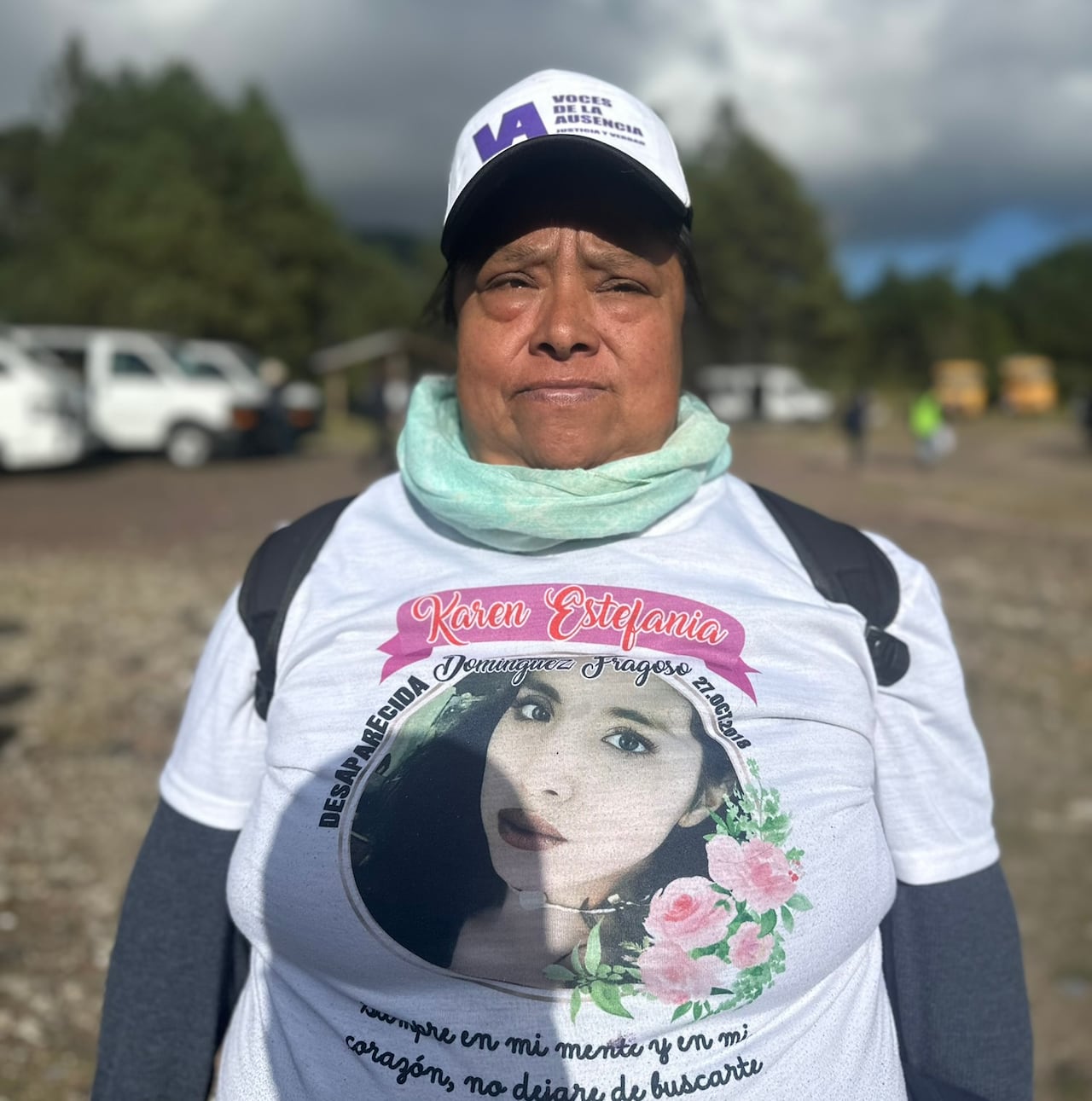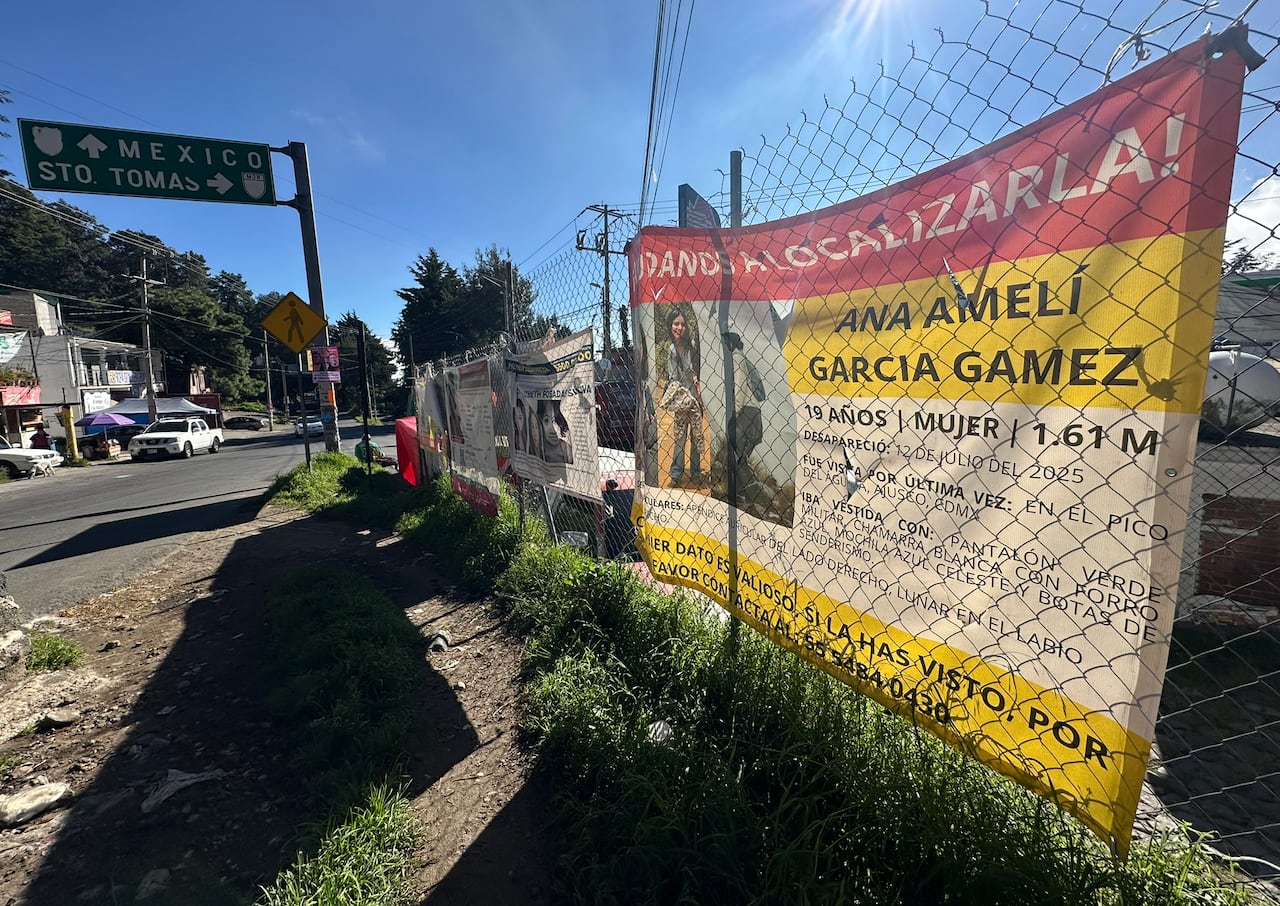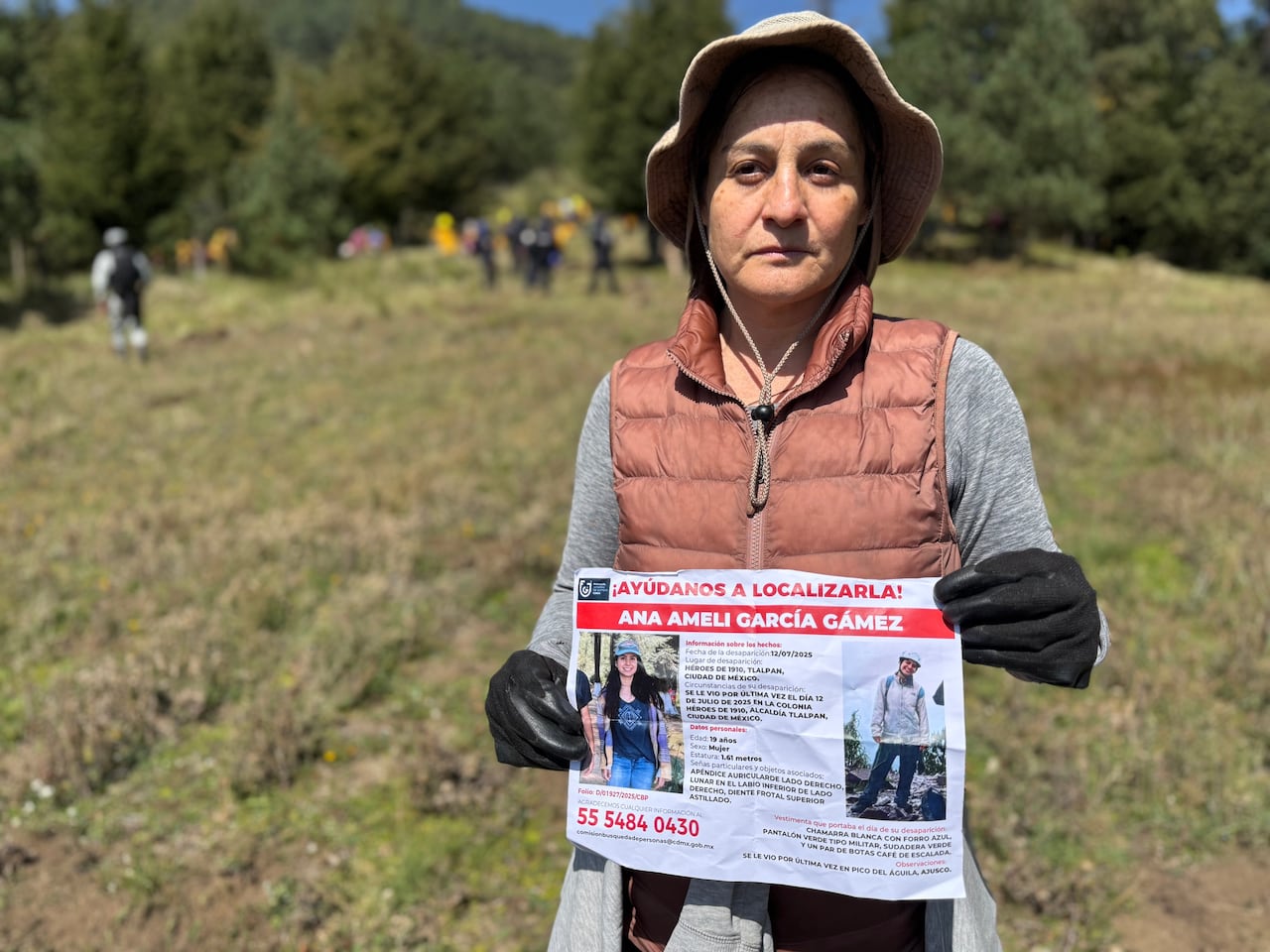There’s a photograph of Jael Monserrat Uribe from when she was 10, standing in the snow on Parliament Hill during a trip to Canada, a place she’d dreamed of visiting because she heard it was the home of Winnie the Pooh, her mother said.
But that was another life.
Jacqueline Palmeros wore a white T-shirt with a different photo of her daughter on a recent Wednesday. She is a young woman in this image; a tightly cropped portrait, hand pressed against her cheek, framed by the words, “I am my daughter’s voice.”
The photo was used in a missing persons poster published by Mexico City’s Attorney General’s Office after she disappeared at 21 years old, on July 24, 2020 — one of the tens of thousands who have gone missing across a country convulsed by years of cartel and state-fuelled violence.
This same photo now lies across a heart of concrete poured and moulded into the earth, a memorial for Monserrat Uribe. The tribute, with a cross and a statuette of the Virgin Mary, sits near where her partial remains were found last November, about 60 metres down an embankment.
The remains revealed she’d been shot in the head.
Palmeros returned to this spot, a lookout called el Llano de Vidrio — the Plains of Glass — in Cumbres del Ajusco National Park, a mountainous and remote region on the southern edge of Mexico City, to search for the rest of her daughter’s body.
“If God wants, I want to return her whole, because I gave birth to a complete daughter,” said Palmeros, the founder of a collective for the families of the disappeared called Una Luz en El Camino — a Light on the Path.
“I want to know what happened to her.”
New search strategy
A few hundred metres away — working from the edge of a highway that cuts through the park and down steep ravines, beneath stands of pine trees — dozens of forestry workers, firefighters, physical anthropologists and members of Palmero’s collective — mothers still searching for their children — used machetes, rakes, weed whackers and their hands, to clear brush and scrape soil, metre by metre, searching for any evidence of human remains.
Cadaver dogs and their handlers darted through the foliage.
This was one of four teams on a four-day, multi-agency search operation, involving hundreds of people between Oct. 21 and 24 across several zones of the nine-square kilometre park which includes the city’s highest point, Eagle Peak, which rises 4,000 metres above sea level.
Mexico City is the first jurisdiction in the country to use this type of pattern-based strategy in the search for the about 7,000 people listed as disappeared in the capital, the sixth highest among all states in the country. The list grew by 2,000 over the past 12 months, according to the National Registry for Disappeared and Missing Persons, created in 2017.
“We had, in the past, smaller searches — in one place or another, depending on the investigation,” said Luis Gómez Negrete, head of the Commission for the Search of Persons of Mexico City.
“Now we are gathering cases, defining an area of interest and bringing all the resources available to support the search in this area.”
After developing geographical links between cases, city officials, working through a cabinet created this year to deal with the missing, develop a list of priority areas to target for searches.
The commission led a search in late August and early September through the Sierra de Guadalupe, a mountainous area on the city’s northern border, that was connected to 183 cases, the most in the city.

During that search, an elderly man was found with serious injuries who appeared to have been dumped and left to die. The search also led to 11 possible findings of human remains.
Officials found that the Ajusco park, which also spreads over the borders of Mexico State and the state of Morelos, was connected to the second highest number of cases in the city — 96.
‘Somebody took her’
“I don’t just look for my daughter, but all of those who we miss,” said María del Rocio Fragoso, who drove in from Huixquilucan, a municipality west of Mexico City.
She wore a white shirt with the image of her daughter, Karen Estefanía Domínguez Fragoso, 23, who disappeared on Oct. 21, 2018, after she left her workplace in Mexico City, minding the till at a place selling construction material.
“There have been many disappeared and several have been found around here, ” said Araceli Olmedo Cruz, who was raking along a steep embankment beneath a stand of pines.
Olmedo Cruz, likewise, wore a shirt with the photo of her son Benjamín Echeverría who disappeared at 19 years old on April 13, 2024, after he was invited to a party in the borough of San Miguel Ajusco, which sits just below the park.

“We miss him a lot,” she said.
On a chain-link fence, along the winding road through San Miguel Ajusco, hangs a banner with the words, “Help us find her!” written in white against red across the top.

There is a photo of Ana Amelí García Gámez on this banner, taken on the Saturday in July, when she vanished five days before her 20th birthday while hiking alone toward Eagle Peak.
García Gámez is wearing a white climbing helmet and a small, sky-blue backpack in the photo. She is standing in profile along a hiking trail, looking somewhere beyond the left margin of the frame.
“She loves nature, she’s an artist, she paints landscapes,” said her mother, Vanessa Gámez.
There are other faces of the missing on banners and posters along this route, including that of a student who was kidnapped last year in the park and held for ransom which his family couldn’t afford.
Some of the photos have faded with the years, held by peeling tape to telephone poles.
“We all, as a family, we are so broken right now … We were destroyed that day. Our peace, our hearts, our entire lives,” said Gámez.
“You start losing your soul, you get sick.”
Gámez doesn’t believe she’ll find Ana Amelí here. After her daughter failed to come home on July 12, her father, brother and local authorities began a search with dogs and drones that lasted three weeks.
They found no trace of her.
Gámez believes her daughter was taken.
Nearly 130,000 people have gone missing across Mexico in the past decades. For The National, CBC’s Jorge Barrera joins families on a search for remains on the southern edge of Mexico City to learn more about the people known as the ‘disappeared.’
“Somebdoy took her,” she said. “My daughter is not here. My daughter has been kidnapped.”
There are two main categories used by Mexico’s national registry that keep track of the vanished — disappeared and missing.

If authorities suspect a case may be linked to foul play, it’s classified as disappeared. García Gámez is classified as disappeared.
Families — who have borne the weight of searching, alone for years — and human rights groups say Mexico remains in a crisis of disappearances.
There are over 130,000 people listed as disappeared or missing across the country, according to the national registry, putting Mexico in a league with countries like Syria and Colombia that have suffered through civil war and other prolonged armed conflicts.
Nearly 90 per cent of Mexico’s cases have been registered since 2006 when then-president Felipe Calderón launched a so-called war on drugs and cartels.
Calderón used federal troops to attack what he called cartel strongholds, triggering a bloodbath that saw tens of thousands of people killed and disappeared during his six-year term.
And the killing has continued.
This past March, searches by family-formed collectives discovered cartel-linked mass graves and cremation sites in Teuchitlán, Jalisco, and in Reynosa, Tamaulipas. In Jojutla, Morelos, 141 bodies were found in clandestine graves in 2022 and 2024.
During the first half of 2025, 45 people vanished daily across the country, up from a rate of 26 a day the year before, according to a report authored by 120 collectives and Mexican civil society groups and filed in September with the UN Committee on Enforced Disappearances (CED).
The committee says it has put the situation under review, citing evidence that enforced disappearances were unfolding in a “widespread or systematic way” across the country.
The UN entity also said it has also received “reliable information about the possible participation of state agents,” either directly or indirectly, in cases of forced disappearances.
The government of Mexico has disputed that, saying the state is no longer involved in systematically disappearing its citizens. It says it is now working to find the vanished through laws and federal entities focused on the issue.
“The disappearances that exist in Mexico are, in the great majority of cases, linked to organized crime,” said Mexican President Claudia Sheinbaum on Monday.
“It is not state violence like it was in the 1960s, 1970s and even in the 1980s.”
The government of Mexico and its military targeted civil society groups, activists and guerillas during that era and used “forced disappearances for political reasons,” said Sheinbaum.
The crisis is not only in the numbers of the vanished, or those who disappear them, but also in the institutional failure to punish perpetrators, according to the report filed with the CED.
The report noted that between 2017 and January 2025, “only 373 convictions have been handed down for forced disappearances.”

During that same period, over 65,000 names were added to the national register of the vanished.
Palmeros lives this reality.
Two people were initially arrested in connection with her daughter’s disappearance, but they were released by a judge due to lack of evidence, she said.
“The police … did not do the job like they should have,” said Palmeros.
“We are still in this process, trying to find justice.”
Gámez says she is also frustrated with how authorities are investigating her daughter’s disappearance.
“We are desperate because the investigators don’t investigate … Our authorities are waiting for us to get tired,” she said.
“It’s so sad and it’s so hard, but love makes you stronger. I need to find her.”
Mexico City’s Attorney General’s Office, which oversees the branch responsible for criminal investigations involving missing person’s cases, did not respond to repeated requests for comment.

(Jorge Barrera/CBC)



